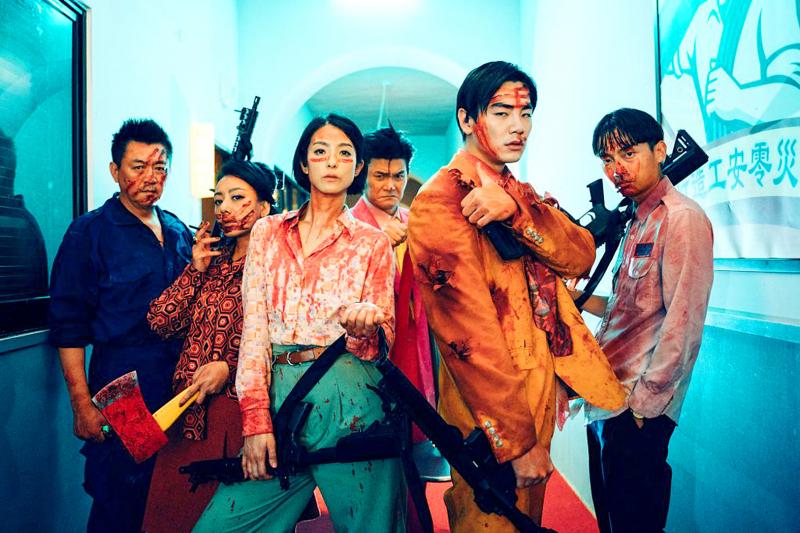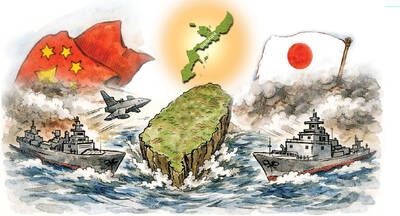The beginning of Get The Hell Out (逃出立法院) features the following disclaimer: “If you choose the wrong movie, you only have to wait 90 minutes; if you choose the wrong legislator, you have to wait four years.”
The people certainly chose the wrong lawmakers in this absurd satirical romp, as an ill-fated government scheme to get rich through an international venture (they call it ‘diplomacy’ here, of course) literally turns the entire legislative body, as well as the president, into bloodthirsty zombies.
Get The Hell Out is a relentless caricature of the nation’s fight-happy Legislative Yuan, government bureaucracy, rabid media industry and other issues such as authorities colluding with corporations to raze villages and build harmful factories. Director Wang I-fan (王逸帆) doesn’t just satirize the infamous legislature, he pokes fun at a wide range of uniquely Taiwanese phenomena, and one would need to be very familiar with the nation’s pop culture, web celebrities and recent sociopolitical events to get all the references in this film. If you don’t, the film is just another gory and campy zombie movie that is not worth your time.

Photo courtesy of CPT Entertainment
The film was slated for release in April, but the COVID-19 pandemic pushed it back until last week, which actually makes it even more relevant as the Legislative Yuan descended into violence again last month over Chen Chu’s (陳菊) appointment as Control Yuan president. The themes of (zombie) pandemic control and “Taiwan Can Help” would also resonate a lot more with audiences now than in four months ago.
Stylistically, Get The Hell Out is Taiwanese mainstream cinema’s trademark over-the-topness taken to the extreme as the characters use video game moves to fight infected Taoist priests and machine-gun toting Centers of Disease Control staff, and it also takes a page from Western cult movies with tons of blood and exaggerated sequences.
The nonstop zaniness gets tiring, though, especially in the middle of the film where much screen time is wasted on brainless battle and chase scenes. One would expect more given the loaded premise and scathing first half, as the plot gets caught up in its own shenanigans and loses its way. At points, it seems like Wang is just using the Legislative Yuan as a pretext to make a crazy zombie flick, whereas he should have been using the zombie pandemic as a device to delve deeper into government and social dysfunction.
Despite the missed opportunities, the movie still entertains overall, and serves as an example of where these otherwise tired tropes make sense, as there’s no better way to criticize the already ridiculous phenomena of brawling legislators than with even more ridiculousness.
The leads are Ying-ying (Megan Lai, 賴雅妍), a legislator dedicated to saving her hometown from being turned into a factory who loses her job after a beating up a paparazzi, and Yu-wei (Bruce Hung, 禾浩辰), a meek Legislative Yuan security guard who unexpectedly replaces Ying-ying and is caught between the warring factions. Of course, besides the zombies, the heroes also have to deal with the corrupt gangster-politician Li (Wang Chung-huang, 王中皇) who wears a bright magenta suit and struts around with his crew of bizarrely-dressed lackeys who call themselves “The Better Generation.”
Wang smartly steers clear of political factions, making the conflict more of a good-versus-evil between politicians who act out of greed and those who actually want to help society.
Amidst the chaos, Wang still tries to deliver an uplifting message about identifying with and protecting one’s homeland, whether it be a threatened seaside village or the entire nation. With many Taiwanese disillusioned in their country and wanting to “get the hell out,” Wang’s sentiment is definitely relevant, but this theme does not come through strongly enough and is buried in the frenetic action.
The transformation of top politicians — including the president — into zombies ultimately allows voters a second chance at choosing the right candidates, but will their replacements simply continue the ways of their predecessors? The nation’s legislators have been exchanging blows since the 1980s. Will things in Taiwan ever change? Is it worth staying and trying to make a difference? These are valid questions that Wang does explore — one just wishes he would have toned down the action just a bit to make more room for contemplation.

Most heroes are remembered for the battles they fought. Taiwan’s Black Bat Squadron is remembered for flying into Chinese airspace 838 times between 1953 and 1967, and for the 148 men whose sacrifice bought the intelligence that kept Taiwan secure. Two-thirds of the squadron died carrying out missions most people wouldn’t learn about for another 40 years. The squadron lost 15 aircraft and 148 crew members over those 14 years, making it the deadliest unit in Taiwan’s military history by casualty rate. They flew at night, often at low altitudes, straight into some of the most heavily defended airspace in Asia.

Taiwan’s democracy is at risk. Be very alarmed. This is not a drill. The current constitutional crisis progressed slowly, then suddenly. Political tensions, partisan hostility and emotions are all running high right when cool heads and calm negotiation are most needed. Oxford defines brinkmanship as: “The art or practice of pursuing a dangerous policy to the limits of safety before stopping, especially in politics.” It says the term comes from a quote from a 1956 Cold War interview with then-American Secretary of State John Foster Dulles, when he said: ‘The ability to get to the verge without getting into the war is

Beijing’s ironic, abusive tantrums aimed at Japan since Japanese Prime Minister Sanae Takaichi publicly stated that a Taiwan contingency would be an existential crisis for Japan, have revealed for all the world to see that the People’s Republic of China (PRC) lusts after Okinawa. We all owe Takaichi a debt of thanks for getting the PRC to make that public. The PRC and its netizens, taking their cue from the Chinese Communist Party (CCP), are presenting Okinawa by mirroring the claims about Taiwan. Official PRC propaganda organs began to wax lyrical about Okinawa’s “unsettled status” beginning last month. A Global

Like much in the world today, theater has experienced major disruptions over the six years since COVID-19. The pandemic, the war in Ukraine and social media have created a new normal of geopolitical and information uncertainty, and the performing arts are not immune to these effects. “Ten years ago people wanted to come to the theater to engage with important issues, but now the Internet allows them to engage with those issues powerfully and immediately,” said Faith Tan, programming director of the Esplanade in Singapore, speaking last week in Japan. “One reaction to unpredictability has been a renewed emphasis on